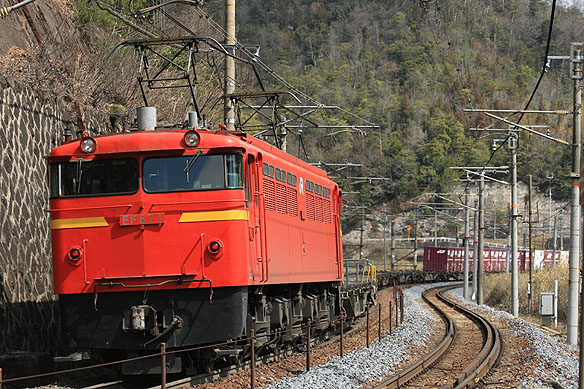Background and overview
Since the gradient frequently exceeds 2.25% between Seno and Hachihonmatsu
of the Sanyo line, a bank engine is coupled with the rear of a freight
train. Bank engines, double head of EF59, were used on heavy freight trains.
EF61-200 engines were used on the other freight trains. Japan National
Railways (JNR) developed new bank engines, the performance of which is
able to push heavy freight trains by one locomotive. As the result, JNR
remodeled EF60 into a new bank engine, EF67-0, in order to displace EF59.
Car body
Their body is carried over from that of EF60. A pass-through door and a
deck to watch coupling operation are fitted at the Osaka end. The coupler
at the Osaka end is equipped with the automatic release unit and silicon
shock absorber, SHD93. Current collectors were changed into cross-arm type,
PS22B. Livery is vermilion color, which imagined the maple that is the
symbol of Hiroshima Prefecture.
Traction unit and auxiliary equipments
EF67 adopt chopper control system to improve adhesion performance. Regenerative
braking system is incorporated into only intermediate bogie as holding
brake system for the down graded route. Their traction motors, MT52, with
a power output of 475kW carried over from EF60 are more powerful than those
of EF60 because of increased terminal voltage.
Operations and withdrawal
EF67-0 vehicles have been used on the bank engine between Seno and Hachihonmatsu.
After introducing EF67-100, only EF67-0 vehicles had been used on the freight
train to uncouple while running. After discontinuing uncoupling while running
in 2002, EF67-0 vehicles and EF67-100 vehicles have been used commonly.
EF67-0 vehicles began to be displaced with EF210-300 vehicles from 2013,
and remaining EF67-0 had been withdrawn in 2014. |
|



